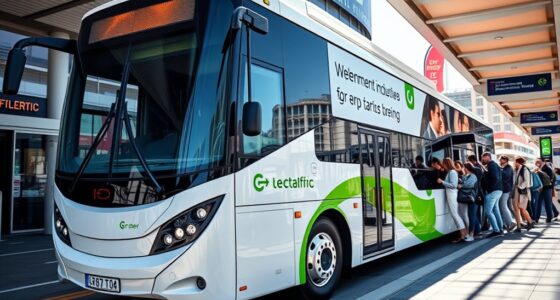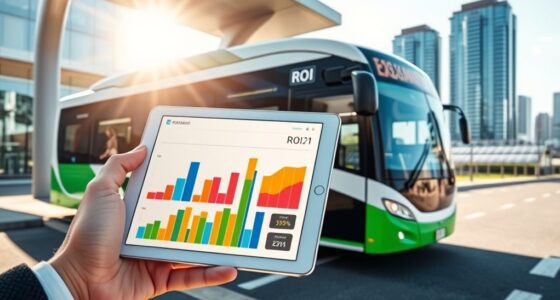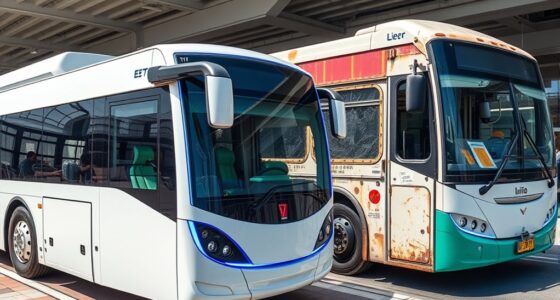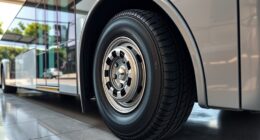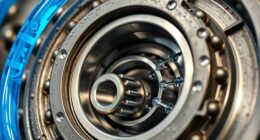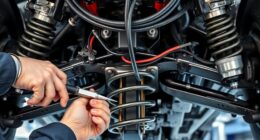Electric buses cut maintenance costs by having fewer mechanical parts, which means less wear and fewer breakdowns. You won’t need to worry about costly aftertreatment systems or frequent oil changes. Regenerative braking extends brake life, saving on replacement expenses. Plus, their advanced technology streamlines diagnostics and boosts durability, leading to less downtime. If you want to discover how these savings add up over time, keep exploring the economic benefits of electric bus maintenance.
Key Takeaways
- Fewer mechanical parts in electric buses reduce repair costs and downtime, lowering overall maintenance expenses.
- Eliminating aftertreatment systems like DEF tanks cuts maintenance and replacement costs.
- Regenerative braking extends brake lifespan, decreasing replacement frequency and associated labor costs.
- Simplified electrical systems allow quicker diagnostics and repairs, reducing labor time and expenses.
- Advanced battery technology and longer service intervals lower total ownership costs through reduced component replacements.

Electric buses offer notable maintenance advantages over traditional diesel models, making them a smarter choice for transit agencies. With fewer moving parts, electric motors drastically reduce mechanical complexity. Instead of over 2,000 parts in diesel engines, electric motors contain around 20 components, which means fewer parts to wear out or break. This simplicity translates into lower repair costs and less downtime. Additionally, electric buses eliminate the need for aftertreatment systems like diesel exhaust fluid (DEF) tanks and particulate filters, which are costly to maintain and replace. Without engine oil, there’s no need for oil changes, further reducing routine maintenance tasks and expenses.
Electric buses reduce maintenance costs with fewer parts, eliminating engine oil changes and costly aftertreatment systems.
The streamlined powertrain also means less wear on belts, gears, and other components, decreasing the likelihood of mechanical failures. The brake system presents another area of savings thanks to regenerative braking technology. This system captures energy during deceleration, reducing reliance on conventional brakes by roughly five times. As a result, brake pads last much longer, and brake repair costs decline considerably. Less heat stress on brake components minimizes thermal wear, extending their lifespan and decreasing replacement frequency. These efficiencies cut down on labor costs, as technicians spend less time inspecting, repairing, or replacing brakes. Over the vehicle’s lifetime, these savings compound, making electric buses more economical to operate.
Labor cost reductions are noteworthy because electric buses require fewer technicians per vehicle and shorter service times. The simplified electrical systems mean diagnostics and repairs are quicker and more straightforward, reducing the need for extensive training. Fewer unexpected breakdowns mean less overtime pay for urgent repairs, smoothing out maintenance expenses. Maintenance workflows shift, focusing more on electrical system upkeep rather than complex mechanical overhauls typical of diesel engines. This streamlined approach allows transit agencies to operate with smaller maintenance teams, further cutting costs. Additionally, battery technology continues to improve, increasing longevity and reducing replacement frequency, which further enhances cost savings. Advances in battery management systems are also contributing to longer battery life and safer operation.
Electric buses also eliminate many diesel-related costs. They don’t require DEF refills or particulate filter replacements, and maintenance of fuel injectors, pumps, and fuel filters becomes unnecessary. Since there are no diesel emissions to manage, compliance costs and penalties are avoided, and the risk of diesel fluid leaks or spills is eliminated. All these factors contribute to lower disposal and hazardous waste management costs, making electric buses more environmentally and financially sustainable. Furthermore, the integration of advanced electrical systems and battery technology benefits from ongoing technological innovations that continue to improve efficiency and longevity.
When considering lifetime costs, electric buses offer up to 70% savings compared to diesel counterparts. Maintenance costs are nearly halved, and predictable expenses reduce financial surprises. Longer service intervals and battery longevity offset initial investments, resulting in a lower total cost of ownership. Reduced downtime and consistent performance ensure fleet reliability, while fewer fluid leaks and better weather resilience keep buses operational longer.
The combination of these advantages makes electric buses a compelling, cost-effective choice for transit agencies seeking to improve operational efficiency and reduce ongoing expenses.
Frequently Asked Questions
How Do Electric Bus Maintenance Costs Compare Long-Term to Diesel Buses?
You might wonder how electric bus maintenance costs compare over time to diesel buses. Electric buses typically have lower long-term maintenance costs because they lack engine oil changes, fewer moving parts, and less brake wear due to regenerative braking.
While upfront costs are higher, you save on labor and parts over the years, making electric buses more economical in the long run despite their longer payback period.
What Specific Components Require the Most Maintenance in Electric Buses?
Some might think electric buses require extensive maintenance, but actually, only a few components need regular attention. The battery management systems and motor controllers demand consistent monitoring, while high-voltage power distribution units need careful handling.
Cooling systems and pneumatic parts also require periodic checks. Overall, your focus should be on electrical systems and software updates to keep the bus running efficiently, with fewer mechanical repairs needed over time.
How Does Reduced Maintenance Impact Overall Fleet Management Efficiency?
When you reduce maintenance needs, you boost overall fleet management efficiency. Fewer mechanical issues mean your buses spend more time in service, increasing operational capacity.
You can allocate resources more effectively, cut downtime, and improve scheduling reliability. Plus, proactive maintenance allows you to plan better, minimize unexpected repairs, and extend vehicle lifespans.
Are There Any Hidden Costs Associated With Electric Bus Maintenance?
You ask if there are hidden costs in electric bus maintenance. While they usually cost less to maintain, you should consider high initial purchase prices, specialized maintenance needs, and driver training requirements.
Battery replacements can also be costly over time. These factors can offset some savings, so it’s crucial to plan for these potential expenses when evaluating the overall cost-effectiveness of electric buses.
How Do Maintenance Savings Influence the Total Cost of Ownership?
You see, maintenance savings directly lower the total cost of ownership by reducing ongoing expenses. When you cut costs on repairs, routine services, and parts, you free up funds that can be invested elsewhere or saved.
This makes electric buses more financially attractive over their lifespan, even if their initial price is higher. Ultimately, these savings help you recover your investment faster and improve long-term economic viability.
Conclusion
So, next time you see electric buses gliding silently down the street, remember—they’re not just saving the planet, but also your wallet. Who would’ve thought that avoiding engine oil spills and endless repairs could be such a win? While traditional buses spew fumes and drain your budget, these quiet giants quietly keep more money in your pocket. Ironically, the future of transportation might just be the one that’s easier to fix—and cheaper to run.


